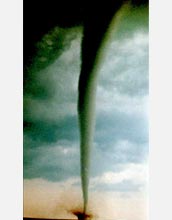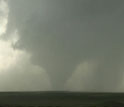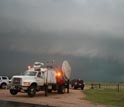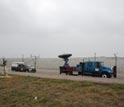Media Advisory 09-012
VORTEX2 Scientists Start Blog on Tornado Research
Track field experiences of scientists over month-long quest to understand tornadoes

VORTEX2 will take nearly two dozen teams of scientists into the paths of tornadoes.
May 5, 2009
This material is available primarily for archival purposes. Telephone numbers or other contact information may be out of date; please see current contact information at media contacts.
VORTEX2, or Verification of the Origins of Rotation in Tornadoes, is the largest attempt in history to study the origin, structure and evolution of tornadoes.
Now, members of the public can follow live reports from scientists involved in the project, funded by the National Science Foundation (NSF) and NOAA.
VORTEX2, has started a blog, allowing members of the public an inside glimpse of the action.
Although the project is not scheduled to start until May 10, 2009, frantic preparations are already underway to move the crews and their equipment into the field.
Some of the questions the teams hope to answer include:
How, when and why do tornadoes form? Why are some tornadoes violent and long-lasting, while others are weak and short-lived? What is the structure of tornadoes? How strong are the winds near the ground and how exactly do they do damage? How can we learn to better forecast tornadoes?
For daily updates on progress on VORTEX2, including photos and video from the field, follow Josh Wurman's blog, http://tornadoscientists.blogspot.com/.
For more coverage of VORTEX2, see http://www.nsf.gov/news/newsmedia/vortex2/index.jsp.
-NSF-
-
View Video
Genesis and evolution of a rain-wrapped tornado observed by VORTEX2 teams in southeastern Wyoming.
Credit and Larger Version -
The Doppler-on-Wheels can go where few instruments have gone before, near tornadoes.
Credit and Larger Version -
Follow the VORTEX2 tornado project on a blog; pictured here is a Doppler-on-Wheels.
Credit and Larger Version
Media Contacts
Cheryl Dybas, NSF, (703) 292-7734, email: cdybas@nsf.gov
The U.S. National Science Foundation propels the nation forward by advancing fundamental research in all fields of science and engineering. NSF supports research and people by providing facilities, instruments and funding to support their ingenuity and sustain the U.S. as a global leader in research and innovation. With a fiscal year 2023 budget of $9.5 billion, NSF funds reach all 50 states through grants to nearly 2,000 colleges, universities and institutions. Each year, NSF receives more than 40,000 competitive proposals and makes about 11,000 new awards. Those awards include support for cooperative research with industry, Arctic and Antarctic research and operations, and U.S. participation in international scientific efforts.
Connect with us online
NSF website: nsf.gov
NSF News: nsf.gov/news
For News Media: nsf.gov/news/newsroom
Statistics: nsf.gov/statistics/
Awards database: nsf.gov/awardsearch/
Follow us on social
Twitter: twitter.com/NSF
Facebook: facebook.com/US.NSF
Instagram: instagram.com/nsfgov





